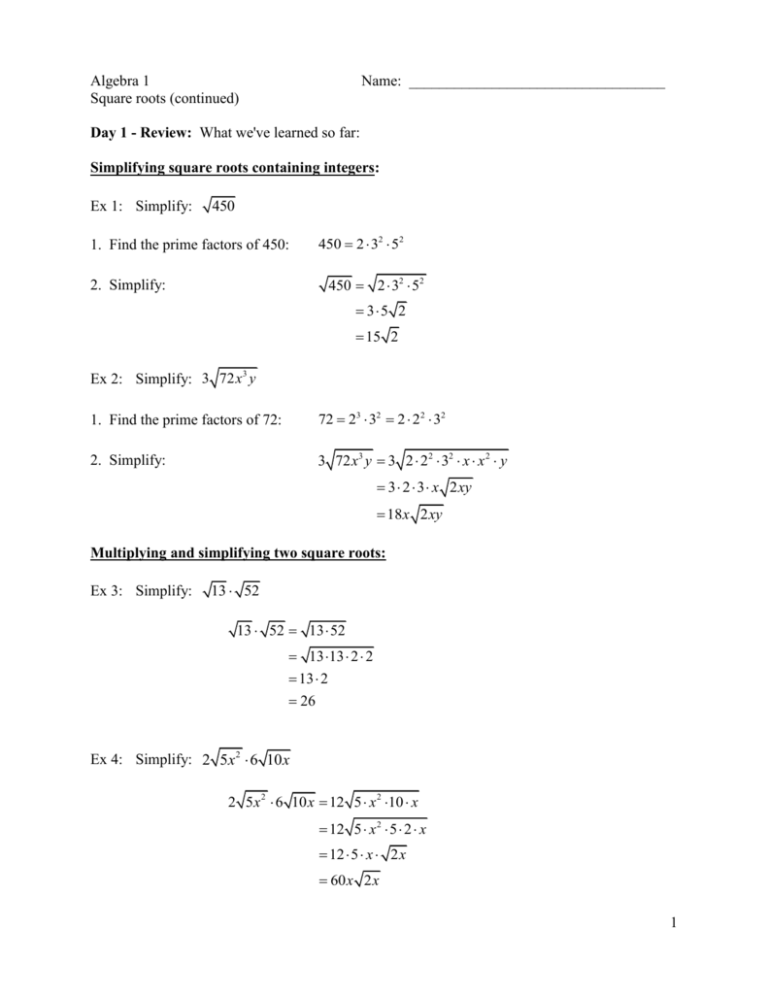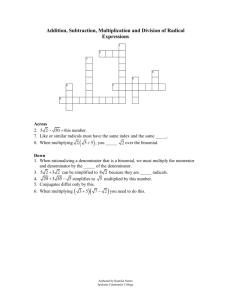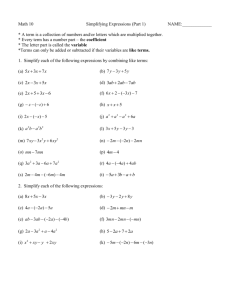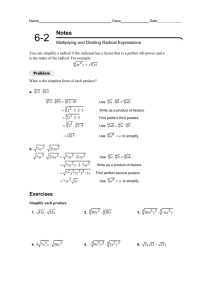Algebra 1
advertisement

Algebra 1 Square roots (continued) Name: __________________________________ Day 1 - Review: What we've learned so far: Simplifying square roots containing integers: Ex 1: Simplify: 450 1. Find the prime factors of 450: 450 2 32 52 450 2 32 52 2. Simplify: 35 2 15 2 Ex 2: Simplify: 3 72x 3 y 1. Find the prime factors of 72: 72 23 32 2 22 32 2. Simplify: 3 72 x3 y 3 2 22 32 x x 2 y 3 2 3 x 2 xy 18 x 2 xy Multiplying and simplifying two square roots: Ex 3: Simplify: 13 52 13 52 13 52 13 13 2 2 13 2 26 Ex 4: Simplify: 2 5x2 6 10 x 2 5 x 2 6 10 x 12 5 x 2 10 x 12 5 x 2 5 2 x 12 5 x 2 x 60 x 2 x 1 Simplifying square roots containing fractions (without rationalizing the denominator): Ex 5: 16 16 4 9 9 3 Ex. 6: 18 18 29 2 32 3 2 4 4 4 4 16 If possible, reduce first! Ex. 7: 12 12 4 4 2 75 25 75 25 5 2 Day 2 - Simplifying square roots containing fractions and rationalizing the denominators: 1. If possible, reduce the fraction by canceling common factors in the numerator and denominator. 2. Simplify the numerator and the denominator (remove “buddies” from the square roots). 3. If a square root remains in the denominator, eliminate it by multiplying both the numerator and the denominator by the same square root. Eliminating a radical from the denominator is called rationalizing the denominator. Examples: Simplify: 5 , 7 3 , 2 9 , 98 2 , 75 56 12 Ex. 1. 5 5 7 57 35 7 7 7 7 77 Ex. 2. 3 3 2 3 2 3 2 2 2 2 2 22 Ex. 3. 9 33 3 3 2 3 2 3 2 3 2 98 14 277 7 2 7 2 2 7 22 72 Ex. 4. 2 2 2 2 3 6 6 6 75 3 5 5 5 3 5 3 3 5 3 3 5 3 15 Ex. 5. 56 12 4 14 14 14 3 14 3 42 4 3 3 3 3 3 33 3 Day 3 - Adding and subtracting, multiplying by FOILing, rationalizing using conjugates Adding and subtracting square root expressions: Adding and subtracting square root expressions is similar to adding and subtracting variable expressions. We can add or subtract variable terms only if the variables are the same; similarly, we can add or subtract square root expressions only if the numbers in the square root symbols are the same: Can be combined: Can’t be combined: 3 2 4 2 7 2 5 6 5 6 is similar to 3x 4x 7 x is similar to x y x y NOTE: The numbers inside the square root symbols do NOT change when we add or subtract! Examples: Ex. 1. 3 2 9 2 12 2 Ex. 2. 3 5 7 5 4 5 For most problems, we will have to simplify the square root expressions before adding or subtracting: 12 4 3 22 3 4 3 Ex. 3. Ex. 4. 2 10 7 40 2 10 7 2 2 10 2 34 3 2 10 7 2 10 6 3 2 10 14 10 16 10 Multiplying square root expressions by distributing or FOILing: Recall that when multiplying square root expressions, you should a. multiply the numbers outside the square roots together, b. write the numbers inside the square roots as a product but do not multiply the numbers, c. factor and simplify the product inside the square root. These same rules apply when multiplying by distributing or FOILing. Examples: Ex. 1. 2 3 6 3 11 2 3 6 2 3 3 11 2 3 3 2 6 3 11 2 3 2 6 33 6 2 6 33 4 Ex. 2. 3 2 3 2 5 3 3 2 2 35 2 3 3 2 5 33 3 2 15 6 6 5 3 6 14 6 15 9 14 6 Rationalizing denominators by multiplying by the conjugate: Conjugates are the sum and difference of the same two terms. The expressions 7 2 and 7 2 are conjugates. The product of square root conjugates has no square root: Ex. 1. 7 2 7 2 77 72 27 22 7 14 14 2 72 5 A denominator that contains a sum or difference that includes square root expressions can be rationalized by multiplying the numerator and the denominator by the conjugate: Ex. 2 3 3 10 6 10 6 10 6 10 6 30 3 6 10 10 10 6 10 6 6 6 30 3 6 100 6 30 3 6 94 5 Day 4 - Solving square root equations Solving an equation with two square roots: If there is one radical on each side of the equation sign: 1. Square both sides. 2. Solve for the variable. 3. Check for extraneous solutions. Ex. 1. 3x 4 5 x 6 Solving an equation with one square root: If there is one radical in the equation, solve the equation as follows: 1. Isolate the radical. 2. Square both sides. 3. Solve for the variable. 4. Check for extraneous solutions. Ex. 2: Ex. 4: x 7 12 x x6 Ex. 3. x2 6 Ex. 5: 2 x 20 8 6 Day 1 Homework: Do not use a calculator for these problems! 7 Day 2 Homework: Do not use a calculator for these problems! 8 Day 3 Homework: Do not use a calculator for these problems! 9 Day 4 Homework: Do not use a calculator for these problems! 10 Homework answers: Day 1: Day 2: 11 Day 3: Day 4: 12





